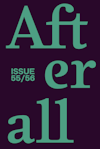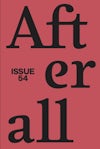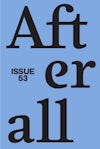
Issue 7
Spring/Summer 2003
Editors: Charles Esche, Thomas Lawson, Mark Lewis, Silke Otto-Knapp, Zoe Crosher.
Founding editors: Charles Esche, Mark Lewis.
Table of contents
Foreword
Contextual Essays
- Shadowland – Claire de Duras, Richard Flood & Toussaint L’Ouverture
- Bring on the Devil: On the Romantic Cult of Radical Individualism – Jan Verwoert
- Remembering Jack Goldstein – Jennifer Bolande
- Jack Goldstein: Obituary – Jean Fisher
- The Writing Life of Giovanni Intra – Mark von Schlegell
Artists
Richard Wright
- De la musique avant toute chose – Ina Blom
- ‘… not so much a style…’ Viva Baja – Mungo Thomson
Jutta Koether
- How to Write About… Jutta Koether – Bob Nickas
- Unfinished Sympathies: On Jutta Koether’s art – Thomas Groetz
Kenneth Anger
- courting ANGER – Alice L Hutchison
- Cultural Bolshevism at Capital’s Late-Night Show: Scorpio Rising – Rachel Moore
The Handsome Family
- Young Americans – Irene Tsatsos
- A Family of Two – Eric Steinman
Jeremy Blake
- Infernal Rodeo – Lars Bang Larsen
- Jeremy Blake: Back to the Future – Cay Sophie Rabinowit
Foreword
Written by Thomas Lawson
There is a sense in which this issue grows out of a day-long symposium and concert sponsored by the Getty Research Institute in Los Angeles. The topic around which that day was focused was the Anthology of American Folk Music…
There is a sense in which this issue grows out of a day-long symposium and concert sponsored by the Getty Research Institute in Los Angeles on 21 April 2001. The topic around which that day was focused was the Anthology of American Folk Music, collected mostly in the 1940s and published in 1952 by a 29-year-old man called Harry Smith, a man Greil Marcus has described as ‘an autodidact, experimental film-maker, dope fiend and alcoholic, freeloader and fabulist’. During that day at the Getty various artists, musicologists, film historians and cultural theorists discussed and reminisced about this singular character of the American avant-garde, showed his abstract animations and collage films, and described his eccentric activities such as collecting and cataloguing paper airplanes found on the streets of New York City.
It might seem exorbitant to claim that this was the seed for an issue of a journal still at the time firmly rooted in London; an issue not actually discussed and planned until the Fall of 2002. But the strange trajectory of thought as it encounters any work of art makes the case simple and even obvious. For as the editorial discussion took shape, two names began to come together in our minds – Kenneth Anger and Richard Wright – and we began to search for an understanding of what made this conjunction so compelling. It was not because of any obvious formal similarity, but more a case of shared attitude, a determined placing of the creative self at odds with mainstream culture, a sense of working from elsewhere. Suddenly I found myself thinking of Harry Smith, and proposing that the missing term might be found in music.
Purchase
The publication is available for purchase. If you would like specific articles only, it is also available individually and to be downloaded as PDFs.
Purchase full publication
Buy via University of Chicago Press
Buy via Central Books
Purchase individual articles
Buy via University of Chicago Press



